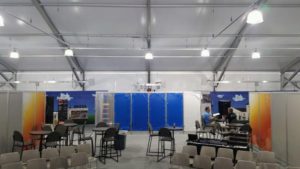When deploying a microgrid, operators can achieve high resiliency. If these microgrids are deployed with…
Universal Electric Provides a Track to the Future
The Smart Energy Microgrid Pavilion (SEMP) at this year’s Solar Power International (SPI) show provided a glimpse into the future of energy production, management and use. What may have gone unnoticed is the central role direct current (DC) products had in making this showcase a success. At the heart of the pavilion was a collection of DC products that were integrated together into a resilient, energy efficient solution. An example of one of these products came from Universal Electric Corporation (UEC). The Field Service Program Manager of UEC, Chris Myer spent some time discussing UEC’s role in the SEMP at SPI 2016.
The key offering provided by UEC for the SEMP was their Starline Track Busway system. This bus system was used to distribute power to the various internal loads from the solar sources outside the pavilion as well as the public utility grid. According to Chris, the important features of this solution included:
- Power both Alternating Current (AC) and DC loads simultaneously.
- Rated up to 1200 amps AC and 2400 amps DC using Two (2) circuits.
- Starline’s new DC power monitor.
- Bus system is complemented by a full suite of components’ including breakers, connectors and 380V DC high-bay lights.
- Simplified connector assembly.
Having the ability to connect both AC and DC loads is a key differentiator for their busway product and is an important feature for those that are looking to build the micro-grids of the future. Today, most end-user loads are AC. Although DC loads are becoming more prominent, the use of these loads is still small compared to overall AC loads. Products like Starline Track Busway provide end-users the flexibility to leverage their existing loads while at the same time incorporate more energy efficient and potentially cheaper DC solutions.
One of the key factors in any building project are concerns related to capital and operating costs. Although DC solutions can be inherently more energy efficient, and thus provide reduced operating costs, Chris does not feel lowered operating cost will be the primary driver for DC solutions. Quoting Chris, “The more solar is used, the more there will be a need for native DC loads. Efficiency gains would not be the major driver. Simplification of the power delivery structure will certainly be a stronger driver. When economies of scale are in place, Capex decreases will also be a bigger driver.”
Chris provided a real world example of how DC technologies can impact today’s manufacturing facilities by citing his experience converting the UEC manufacturing facility to use DC powered lights. As part of an internal expansion project, UEC installed 51 kW of solar panel capacity on their roof and coupled it to 90 kWh of battery storage. For their application, the battery storage provides 4-5 hours of power once renewable sources stop generating energy. This generation and storage system was connected via the Starline Track Busway to DC LED lights that illuminate the new production area. When asked about other loads that could benefit today from DC technologies, Chris mentioned electric vehicle charging (residential) and fork truck batteries (commercial). UEC is quite pleased with the results of this project to date.
One of the biggest challenges in evaluating the implementation of a DC micro-grid is determining whether the long term costs saving outweigh the costs related to initial setup and maintenance. These calculations are very much dependent on the current subsidies available from various government authorities and the relationship of the microgrid to the public utility grid. When discussing this with Chris, he mentioned their payback period could be approximately 7 years, without any government incentives. Furthermore, since their microgrid setup does not push power back to the public grid, they are not concerned with public utility power purchase agreements. UEC’s approach represents a free market methodology of improving energy resiliency, decreasing long term energy costs, and reducing the public utility load. Furthermore, their solution is sustainable from a carbon reduction perspective. All of this has occurred without the need for subsidies from taxpayers. Looking back at the SEMP demonstration, and the accomplishments of UEC in the real world, there exist today viable and compelling options to reduce capital and operating costs, increase reliability and gain (carbon) sustainability for free. Given this reality, micro-grids built on DC technology should become more commonplace.

